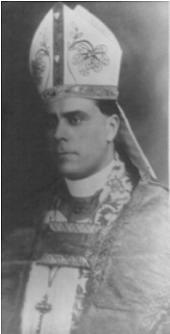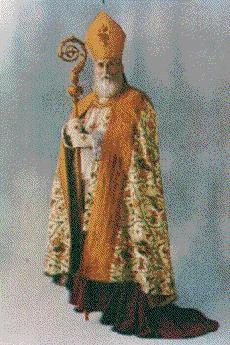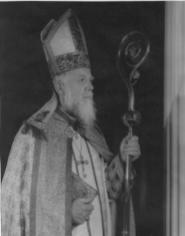![]() Under
Construction!
Under
Construction!
A Short History of the Liberal Catholic Church
and St. Raphael's Parish
Saint Raphael's
Church
The Liberal Catholic Church of the San Francisco Bay Area
Member Church of The Liberal Catholic Church Province of
the United States,
Regionary Bishop: The Right Rev. Lawrence Smith
A part of the world wide Church,
Presiding Bishop: The Right Rev. Johannes van Alphen
Contents:
Early History
The Church Comes to the United States
A Bishop for the United States (to be continued...)
Early History
The Liberal Catholic Church was born as an Apostolic body in the blazing light of "New Age" intellectual freedom. It embraced the rediscovered Ancient Wisdom that wrenched an thinking minority from the stultifying dogmatism of the traditional orthodox, Christian Churches.
In the latter part of the 19th century, Helena Petrovna Blavatsky (daughter of a high-ranking officer in the Russian army and nobleman) emerged from an extended seclusion in the Himalayan monasteries to declare a new message, yet in a real sense also an ancient message, of Creation and Human Evolution. We are all, brothers and sisters within the One unifying principle and Force which we call God, the Creator the One origin of all existence. We all evolve through a long series of material manifestations into beings of indescribable spiritual beauty and wisdom, guided by God's Law of Karma and the Dharma (the goals of our lives) by which he guides our progress. This is His grand scheme of creation in short. The choices we make determine the detailed path we follow (whether it be short and fulfilling or long tortuous and painful) to that glorious goal.
What all that means in detail is to be discovered by each student of life, by each Theosophist (from the Greek: Theos or God, and Sophia or knowledge, or Theosophia - Divine Wisdom). In 1875, with that object in mind, the Theosophical Society was founded by Blavatsky and Henry Steel Olcott, a Civil War veteran. [see "The Willow in the Tempest." by Robert Norton ( The St. Alban Press, Ojai, CA ) p. 4-7]
The objects of that Society are a clear challenge to dogmatic systems and to many social conditions of that- and our time:
1) To form a nucleus of the Universal Brotherhood of Humanity without distinction of race, sex, creed, caste or color.
2) To encourage the study of Comparative Religion Philosophy and Science.
3) To investigate the unexplained laws of nature and the powers latent in man.
Blavatsky, Olcott, and others who joined them traveled widely and established Theosophical study centers across our Globe, that were supplied with books and theosophical journals from Headquarters in Adyar, Madras, India.
The Theosophical Society in England became a magnet for those clergy that chafed under the authoritarian decrees of Pius IX and his predecessors. In the mean time the independent Dutch Catholics, in conflict with Rome, who refused them Bishops, were rescued by Bishop Varlet who had left Paris to take up a new post in Babylon. On His way through Holland he confirmed 604 Catholics before moving on. Deposed by Rome for this act of insubordination he returned to Holland and consecrated several Bishops, thereby establishing what is called the Old Catholic Church of Holland. [for additional details see The Willow in the Tempest by Robert Norton (The St. Alban Press, Ojai, CA ), p.2-4 and The Apostolic Succession in the Liberal Catholic Church, by A. W. Cockerham (St. Alban Press)]
Members of the liberal movement in England, many of whom were or became Theosophist in the ensuing years, pleaded for a Bishop for England from the Old Catholic Bishop of Utrecht. The result was the consecration of Bishop Arnold Harris Mathews, who became the head of the Old Catholic movement in England. After Ordaining Wedgwood to the priesthood and Consecrating Frederic Samuel Willoughby to the episcopate he retired from the Old Catholic movement. Bishop Willoughby consecrated Bishops King and Gauntlet on Sept. 25, 1915, and subsequently the three presided over the consecration of father James Ingall Wedgwood to the Episcopate on 13 Feb. 1916. The consecration "took place in the Co-Masonic Temple at 13 Bloomfield Rd. Maida Vail, London, W.9," according to "the Roman rite translated into English as contained in THE OLD CATHOLIC MISSAL AND RITUAL." (see The Apostolic Succession p. 23)

|

|

|
| +James Wedgwood, LCC | +Charles W. Leadbeater, LCC | +Charles Hampton, LCC |
Bishop James Ingall Wedgwood was the seed from which the Liberal Catholic Church was to grow, for right after his consecration he took charge of the Old Catholic movement in England. He appointed Bishop King as his assistant and left for Australia to consult with Father Charles W. Leadbeater, a clairvoyant mystic Anglican priest and Buddhist, thoroughly trained in theosophical thinking.
Wedgwood re-ordained Leadbeater conditionally through minor orders and to the priesthood and than consecrated him to Bishop in the Old Catholic Church on 22 July 1916 according to the same ritual used to consecrate Wedgwood (Apostolic Succession p. 29). Together they set to revising the Liturgy in the OLD CATHOLIC MISSAL AND RITUAL. This work occupied much of their time during the following two years. A small liturgy was authorized by Wedgwood "for use in the Churches of our Movement in the United Kingdom, Australia, New Zealand and America," early in 1918. By June 1919 the revision of the liturgy was finished. This revision is in current use (with minor modifications). During that work Leadbeater wrote his favorite coworker Mrs. Annie Besant:
We wish for your presence every day while we are working at the reconstruction of the Catholic Ritual. Your splendid gift of language, your wonderful power at putting things poetically would be invaluable to us. This thing ought to be done well -- the Ritual of His Church, the only one combining the power of the ancient Church with a true theosophical expression of the real relation between God and man; all the great poets of the age ought to be working on it. . . .
Mrs. Besant, who worked with Leadbeater on a number of his clairvoyant investigations and shared with him the believe that the second coming of Christ so eagerly awaited by many Christians, would bring a new Christian message amplifying the than prevailing Theosophical views. She declared ["The Willow in the Tempest." p. 14-15]:
[the church] '"has in it the essence of the divine teaching for the people, freed from some of the incongruities which have grown around the teaching of Christ and His message transmitted by His disciples." And this newest church "should be at the very heart of the teaching that the Christ will give."
While one may consider this presumptuous, we leave it to the student to decide whether message by Krishnamurti of liberation in spiritual unity free from organizational constraints was Christ inspired.
The name of the Church came under consideration at two different meetings of the Episcopate. ' Early in December 1917 Bishop Wedgwood called together a joined clerical and episcopal Synod in London . . . At this meeting recent criticisms of the English movement by the Archdiocese of Utrecht were considered. . . it was provisionally agreed that subject to the views of the churches in Australia and America' the official title of the church should be altered to the "Liberal Christian Church (Old Catholic)."
The name of the Church came up again at a meeting of the members in Sydney, Australia. Several suggestions were made and finally the name THE LIBERAL CATHOLIC CHURCH, which Wedgwood preferred, was agreed upon. Hereby the new church was officially detached from its parent body, while continuing through its Apostolic Succession to be a part of the ONE HOLY CATHOLIC APOSTOLIC CHURCH OF CHRIST.
The Church comes to the United States.
During the rewriting of the Liturgy, Wedgwood continued his evangelical travels ,with a visit to the United States,to establish the Church in the Americas. While attempting to cement relations with already established Old Catholic Churches in the States he ordained three men (Robert Kelsey Walton, Member of the Theosophical Society; Gregory Samuel Lines, Episcopal priest and Theosophist; James Grattan Mythen, who questioned his Episcopal Orders) to the priesthood in St. Athanasius Episcopal Church, Echo Park, Los Angeles, California on August 14, 1917. With these ordinations and the ordination of Charles Hampton at the Krotona Institute of Theosophy in Hollywood on Aug. 17, the Church was established in California.
After a visit to the TS in Chicago, Wedgwood went to the Theosophical Society Convention in New York, where he ordained Edwin B. Beckwith (a Chicago Theosophist) and Ray Marshall Wardall (Theosophist and Seatle Washington Attorney) to the priesthood. With these the Church gained a foundation in those two cities.
On his second visit to the U.S., Wedgwood confirmed 32 people in the chapel at the Chicago Theosophical Society Lodge in mid-August. He also ordained two more priests, one of whom was Edmunt Sheehan ,who was later to serve the Church as Bishop.
![]() To be continued
soon!
To be continued
soon!